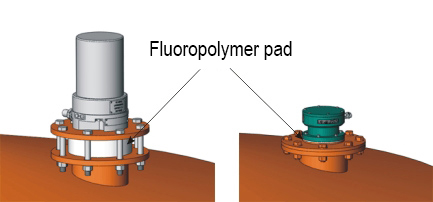Acid and Alkali Level Measurement
Tanks with aggressive products, for instance, acid, have strong corrosion effect on parts in direct contact with the product and the air pocket above it. That is why all contact instruments and classical radar level transmitters for acid level measurement have a measurement element made of special materials, which results in higher prices of instruments and still does not guarantee against corrosion or a level-probe failure.
For example, measurement elements of contact level transmitters (cable or rod) have fluoropolymer coating, which can be damaged during level-transmitter transportation or mounting. Noncontact radar level transmitters use a fluoropolymer rod antenna, which, however, reduces the level-transmitter sensitivity due to a wider measuring-beam divergence angle. Besides, contact of the level transmitter's rod antenna with the acid-vapour-saturated atmosphere often results in “dew” fall on the antenna as well as, consequently, even lower level-probe sensitivity, worse level-measurement stability, and higher measurement errors.
The use of noncontact ultrasonic level transmitters for acid level measurements is also associated with certain difficulties. During acid storage, a large amount of vapours accumulates above the product surface in the tank and non-uniformly spreads throughout the vessel height. The ultrasonic level transmitter measures the level by measuring a sound-wave propagation delay time while the sound-wave velocity strongly depends on the environment where it is propagating, in our case, on the composition of the above-acid atmosphere. Therefore, the sound wave velocity changes many times in an unpredictable manner all the way of sound-wave propagation, from the probe to the acid and back, which significantly increases the level measurement error (if you don't know the exact velocity, you cannot calculate the distance covered in a unit of time) or potentially results in a measurement failure (level loss).
Application specifics
Unlike most radar level transmitters of other brands, level measurement using ULM level transmitters does not require direct contact of the level-probe antenna with the internal tank space as the antenna is not placed in the tank. The ULM-31A1 level transmitter is recommended for level measurement in tanks with aggressive media, being a perfect choice for these tasks.
The level transmitter is installed outside the tank (on its roof) and measures the level avoiding contact with the product. The antenna of the level probe is located fully inside the instrument housing and protected against aggressive product vapours.
How to install ULM level transmitters on the acid-containing tank

| ULM-11 level transmitters ULM-11A1 level transmitters |
ULM-31A1 level transmitters |
This fully prevents contact of the internal aggressive environment with structural elements of the level probe and the antenna (measurement element). ULM level transmitters measure levels of various acids: sulphuric acid, hydrochloric acid, phosphoric acid, nitric acid, hydrofluoric acid, etc.
The level measuring system in the tank farm can consist of several different radar level transmitters of ULM series joined in a unified system. All ULM series radar level transmitters have a fully compatible command system and a unified structural design, which creates a technical solution as efficient in terms of a price/quality ratio as possible, based on ULM level transmitters.